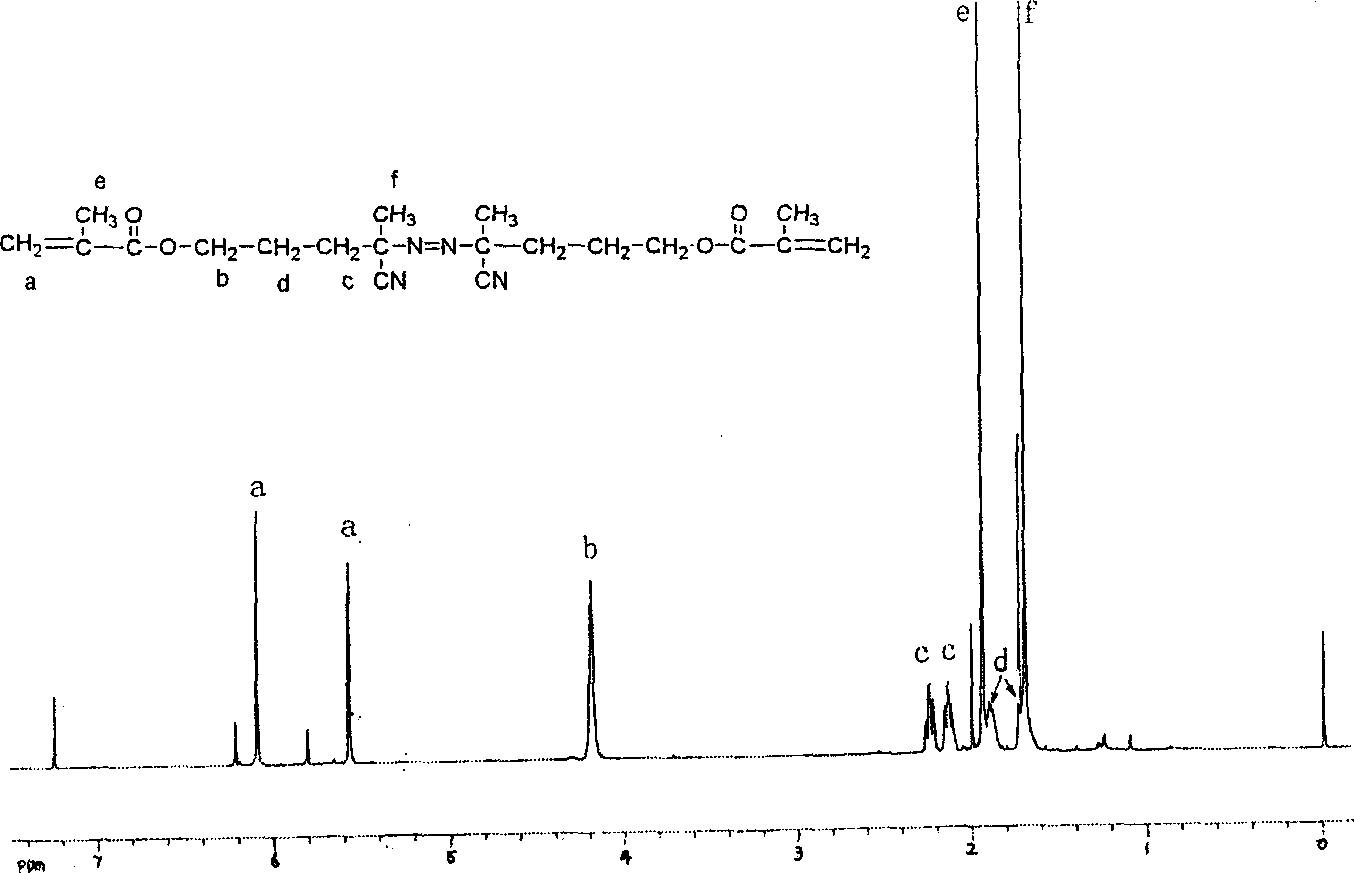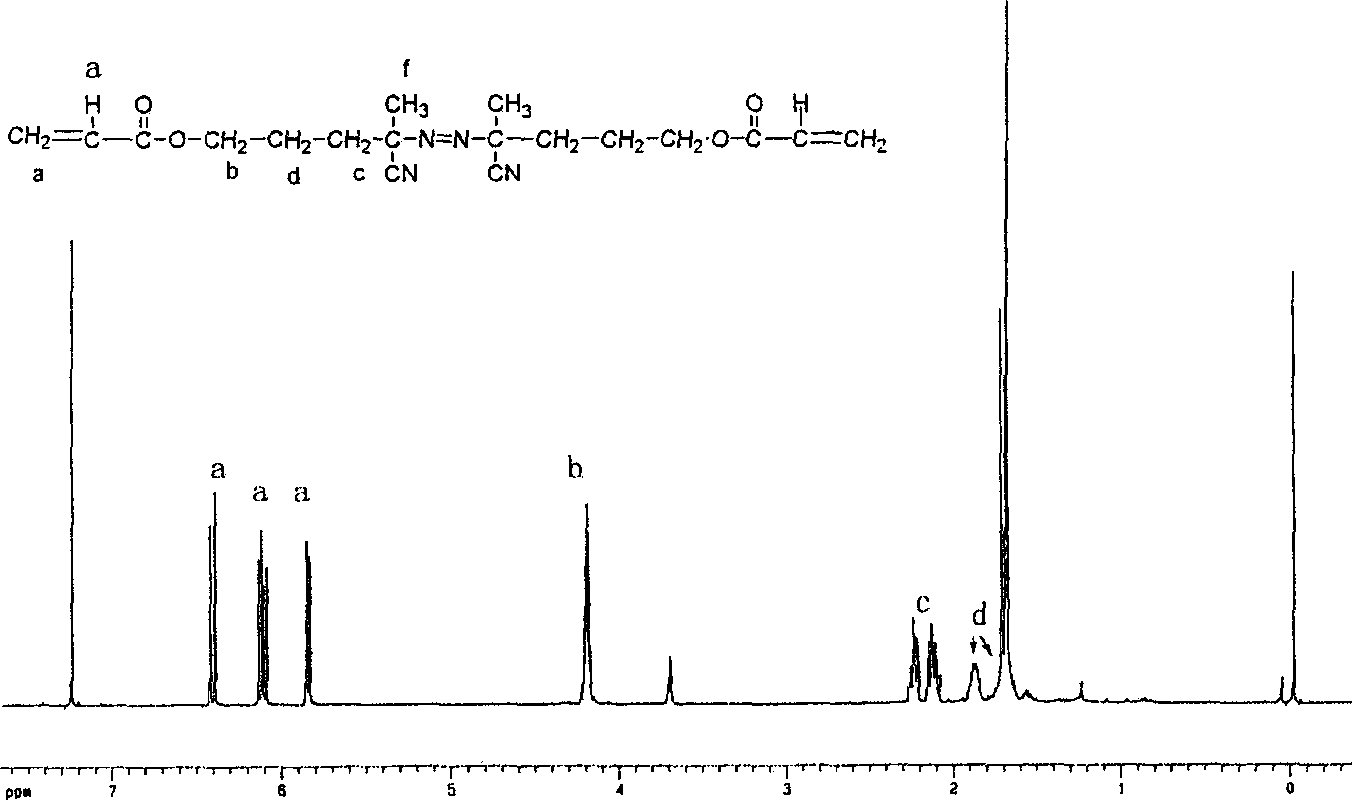Method for promoting grafting efficiency of acrylate core/shell structure latex particle
An acrylate, core-shell structure technology, applied in the field of polymer chemistry, can solve the problem of low grafting efficiency
- Summary
- Abstract
- Description
- Claims
- Application Information
AI Technical Summary
Problems solved by technology
Method used
Image
Examples
Embodiment 1
[0018] First, add 2.94 g of azo-bis(4-cyano)pentanol and 2.70 g of catalyst triethylamine into a three-necked flask containing a magnetic stirring rotor, then add 25 mL of acetone to completely dissolve it, and place the reaction bottle on ice In a water bath (0° C.), 15 mL of an acetone solution containing 2.50 g of methacryloyl chloride was added dropwise. The reaction was stopped after 20 hours of reaction. The solution turns from colorless and transparent to white, which is washed with water, dried, and solvent removed to obtain a light yellow initiator type monomer, i.e. azo-bis(4-cyano)pentyl dimethacrylate. The yield of the product is rate of 74%, the product's 1 H NMR spectrum as figure 1 As shown, no impurities were found.
[0019] Add 120 parts (weight fraction based on acrylate, the same below) of deionized water and 5 parts of sodium dodecylbenzenesulfonate into the three-necked bottle. Add mixed monomers (acrylic acid ester, ethylene glycol methacrylate and az...
Embodiment 2
[0022] First, add 2.94 g of azo-bis(4-cyano)pentanol and 2.70 g of catalyst triethylamine into a three-necked flask containing a magnetic stirring rotor, then add 30 mL of acetone to completely dissolve it, and place the reaction flask on ice In a water bath (0° C.), 4.00 g of methacryloyl chloride was added dropwise. The reaction was stopped after 10 hours of reaction. The solution changed from colorless and transparent to white, which was washed with water and dried to obtain azo-bis(4-cyano)pentyl dimethacrylate with a yield of 83%.
[0023] Add 140 parts of deionized water and 5 parts of sodium dodecylbenzenesulfonate into the three-necked bottle. Add mixed monomers (acrylic acid ester, methylolpropane triacrylate and azo-bis(4-cyano)pentyl bismethacrylate in a weight ratio of 100 / 1.5 / 0.5) under stirring, and emulsify under nitrogen protection for 10 Minutes later, add 0.6 parts of potassium persulfate (dissolved in 30 parts of deionized water), add 0.10 parts of ferrous...
Embodiment 3
[0026] First, 5.90 g of azo-bis(4-cyano)pentanol and 5.50 g of catalyst pyridine were added to a three-necked flask containing a magnetic stirring rotor, 60 mL of tetrahydrofuran was added, and the reaction flask was placed in an ice-water bath (0°C). 8.00 g of methacryloyl chloride was added dropwise. The reaction was stopped after 18 hours of reaction. It was washed with water and dried to obtain azo-bis(4-cyano)pentyl bismethacrylate with a yield of 83%.
[0027] Add 140 parts of deionized water and 4 parts of sodium dodecylbenzenesulfonate into the three-necked bottle. Add mixed monomers (acrylic acid ester, ethylene glycol methacrylate and azo-bis(4-cyano)pentyl dimethacrylate in a weight ratio of 100 / 1.5 / 2.0) under stirring, and emulsify under nitrogen protection for 10 Minutes later, add 0.7 parts of potassium persulfate (dissolved in 30 parts of deionized water), add 0.15 parts of ferrous sulfate, and 0.08 parts of carved white block. The reaction temperature is 7°C...
PUM
| Property | Measurement | Unit |
|---|---|---|
| Particle size | aaaaa | aaaaa |
| Particle size | aaaaa | aaaaa |
| Particle size | aaaaa | aaaaa |
Abstract
Description
Claims
Application Information
 Login to View More
Login to View More - R&D
- Intellectual Property
- Life Sciences
- Materials
- Tech Scout
- Unparalleled Data Quality
- Higher Quality Content
- 60% Fewer Hallucinations
Browse by: Latest US Patents, China's latest patents, Technical Efficacy Thesaurus, Application Domain, Technology Topic, Popular Technical Reports.
© 2025 PatSnap. All rights reserved.Legal|Privacy policy|Modern Slavery Act Transparency Statement|Sitemap|About US| Contact US: help@patsnap.com



